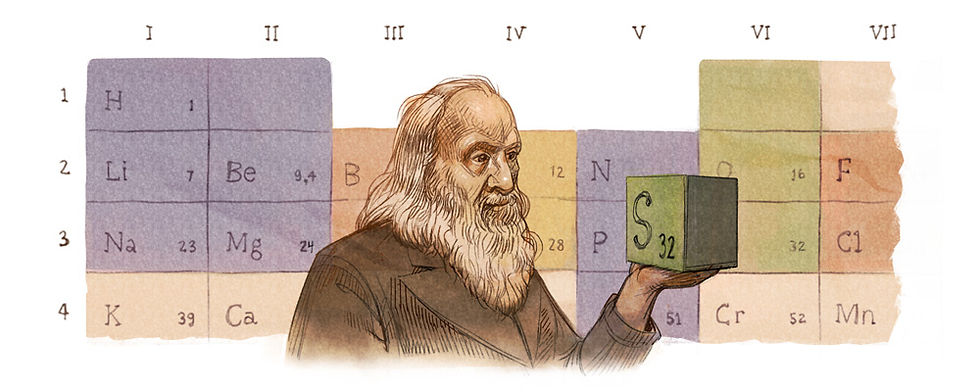STEM GLAM GALLERY: Dmitri Mendeleev
- Wai Hnin Oo
- Jan 20, 2018
- 2 min read

The Periodic Table of Elements is the one of the most recognizable icons in science today. Many of us have seen huge posters of the Periodic Table plastered in science classrooms and lecture halls, and some of us nerds even wear T-shirts with the Periodic Table printed on them! But have you ever wondered how it came to be? Well, you’re about to find out...
The Periodic Table of Elements was invented by a brilliant Russian scientist, Dmitri Mendeleev.
Despite unfortunate events in his childhood, Dmitri Mendeleev graduated as the top student in his college and had been publishing original research papers by the age of twenty. He received his masters degree from the Main Pedagogical Institute in St. Petersburg in 1856 and obtained a professorship at his alma mater in 1864.
As a professor, Mendeleev was charismatic and enjoyed popularity among the students for his knowledge and passion. He wrote textbooks as he taught the subject– in 1861, he published a textbook on organic chemistry, which won the prestigious Demidov Prize. Later on, while he was writing a textbook on inorganic chemistry, he set out to classify the 65 known elements according to their chemical and physical properties. Using a set of cards, he wrote the names and properties of the elements on each card and kept shifting the cards to find a pattern among them. As legend has it, Mendeleev finally had his eureka moment in a dream hours later, where all the elements fell into place in a table as required, and he wrote the information down when he awoke. Thus, The Relation between the Properties and Atomic Weights of the Elements was published two weeks later, and the Periodic Table was born into the scientific world.
However, like many other inventions, the idea of the Periodic Table did not gain much attention at first. In his new method of classification, Mendeleev had made a number of bold predictions: one, that the atomic weights of certain elements were measured incorrectly; and two, he left gaps in his table in anticipation of the discovery of eight new elements and predicted their properties.
As it turns out… Mendeleev was right! With the discovery of the predicted elements (gallium in 1875, scandium in 1879, and germanium in 1886), Mendeleev’s reputation and his Periodic Table shot to fame. In 1905, the British Royal Society gave him its highest honor, the Copley Medal, and in the same year, he was elected to the Royal Swedish Academy of Sciences. Mendeleev continued to win international recognition and received many awards till the end of his career and life in 1907. His legacy lives on in the Periodic Table that we now know and love today.
Sources:
https://www.famousscientists.org/dmitri-mendeleev/
https://www.britannica.com/biography/Dmitri-Mendeleev
https://en.wikipedia.org/wiki/Dmitri_Mendeleev



























Comments